7 Open Water Swimming Techniques Compared: From Beginner to Pro
Discover the pros and cons of 7 essential open water swimming techniques, from efficient freestyle to strategic breaststroke, helping you choose the right approach for any aquatic challenge.
Conquering open water swimming requires mastering techniques that differ significantly from pool swimming. Whether you’re training for a triathlon or enjoying recreational swims in lakes and oceans, the right technique can dramatically improve your efficiency and safety. Understanding which approach works best for your specific needs can transform your open water experience from challenging to exhilarating.
You’ll find that each technique offers unique advantages depending on water conditions, swimming distance, and your personal goals. From the bilateral breathing method that enhances your awareness to the sighting technique that keeps you on course, these seven approaches represent the most effective ways to navigate open waters. We’ve compared them based on efficiency, difficulty level, and situational benefits to help you make informed decisions about your swimming strategy.
Disclosure: As an Amazon Associate, this site earns from qualifying purchases. Thank you!
The Freestyle: The Foundation of Open Water Swimming
The freestyle stroke is the cornerstone of open water swimming, offering the perfect balance of efficiency and speed for navigating natural bodies of water.
Technique Breakdown
The freestyle in open water requires a longer, more powerful stroke than pool swimming. Keep your body position horizontal with a slight head lift for sighting. Your arm should enter the water at a 45-degree angle, pulling straight back with a high elbow recovery. Maintain a consistent 2-beat or 6-beat kick to stabilize your body against currents and waves.
When to Use Freestyle in Open Water
Freestyle is your go-to stroke for nearly all open water swimming scenarios. It’s particularly effective for covering long distances efficiently, swimming against currents, and maintaining speed in choppy conditions. During triathlons or competitive events, freestyle provides the fastest forward propulsion while conserving energy. Switch to this stroke whenever you need to make headway quickly or navigate through challenging sections of water.
Breaststroke: The Visibility Champion
Breaststroke offers unparalleled visibility advantages in open water, making it a vital technique in your swimming arsenal. This stroke allows you to keep your head above water consistently while maintaining forward momentum.
Technique Breakdown
In open water breaststroke, position your body horizontally with shoulders at the surface. Execute a wide arm pull followed by a whip kick, bringing knees up before extending feet outward. Keep your head raised between strokes for continuous forward sighting, creating a rhythm of glide-pull-kick-glide.
When Breaststroke Shines in Open Waters
Breaststroke excels when navigating crowded swim starts or approaching buoys where collision risks increase. It’s invaluable in choppy conditions when you need constant visual awareness or when swimming through debris or vegetation. For triathletes, it’s perfect for course orientation and strategic recovery between freestyle segments.
Backstroke: The Recovery Specialist
Backstroke offers a unique advantage in open water swimming as it allows you to rest overworked muscles while continuing to make forward progress. This technique is particularly valuable during longer events when fatigue becomes a significant factor.
Technique Breakdown
When executing backstroke in open water, maintain a horizontal body position with hips high. Use a continuous arm rotation with hands entering the water thumb-first at 11 and 1 o’clock positions. Focus on a steady flutter kick to stabilize your body against waves while keeping your face clear of water splashes.
Strategic Uses in Open Water Events
Backstroke serves as an excellent recovery technique during long-distance events when your shoulders fatigue from freestyle. Use it briefly when approaching support boats for nutrition, navigating away from sun glare, or relieving neck strain from prolonged sighting. It’s especially valuable during multi-day stage swims when conservation of energy becomes critical.
Sidestroke: The Energy-Efficient Alternative
Technique Breakdown
The sidestroke positions your body horizontally on one side with arms performing asymmetrical movements. Your bottom arm extends forward while your top arm pulls backward along your torso. Your legs execute a scissor kick—the top leg forward, bottom leg back—creating powerful propulsion while maintaining your lateral position. The face remains partially above water, eliminating breathing concerns.
Conservation Benefits During Long Swims
Sidestroke excels at energy conservation, burning up to 30% fewer calories than freestyle while maintaining steady progress. It’s invaluable during marathon swims or when you’re conserving energy between high-intensity segments. The natural breathing position reduces oxygen debt, allowing sustained effort without exhaustion—making it perfect for recreational swimmers tackling longer distances or as a strategic recovery technique in endurance events.
Butterfly: The Power Stroke
Butterfly is the most physically demanding swim stroke, generating explosive power through a distinctive dolphin-like motion that can be both impressive and exhausting in open water conditions.
Technique Breakdown
The butterfly stroke requires synchronized dolphin kicks with a powerful butterfly arm movement. Your body should undulate through the water in a wave-like motion, with both arms recovering simultaneously above the water. Your hips drive the movement while your legs execute twin dolphin kicks for each arm cycle, creating that distinctive butterfly rhythm.
Limited Applications in Open Water
Butterfly isn’t a primary open water technique due to its high energy cost and visibility challenges. You’ll find it most useful for short bursts when breaking through surf zones or powering past obstacles. In competitive settings, butterfly serves best as a strategic tool for accelerating briefly or creating separation from nearby swimmers rather than as a sustained swimming method.
Tarzan Drill: The Sighting Technique
Technique Breakdown
The Tarzan Drill involves swimming freestyle with your head completely out of the water, similar to how Tarzan swims in classic films. Keep your chin lifted just above the waterline while maintaining a powerful freestyle stroke pattern. Your body position will be slightly more vertical than traditional freestyle, requiring stronger kicks to compensate for the increased drag.
Navigational Advantages in Rough Waters
In choppy conditions, the Tarzan Drill gives you continuous forward visibility without breaking your stroke rhythm. You’ll navigate more efficiently around large swells and spot approaching waves before they crash over you. This technique reduces the disorientation that comes with regular sighting in rough waters, helping you maintain a straighter course while saving up to 15% of the energy typically spent on stop-start sighting patterns.
Bilateral Breathing: The Balanced Approach
Bilateral breathing involves inhaling on alternating sides during freestyle swimming, typically every third stroke. This technique creates symmetry in your stroke mechanics while providing comprehensive awareness of your surroundings.
Technique Breakdown
Bilateral breathing requires rotating your head to alternate sides (left, then right) every three strokes. Keep your head aligned with your spine, turning just enough to clear your mouth from the water. Exhale completely underwater between breaths to ensure efficient oxygen exchange. Maintain a steady rhythm and practice equal rotation to both sides.
Adaptability Benefits in Varying Conditions
Bilateral breathing excels in choppy water by allowing you to breathe away from incoming waves regardless of direction. It reduces neck strain by balancing muscle development on both sides and prevents the common “one-sided swimmer” posture. During races, you’ll track competitors on both sides without disrupting your stroke rhythm—a significant advantage in tactical racing situations.
Choosing the Right Technique for Your Open Water Adventure
Mastering open water swimming comes down to adapting your technique to match the environment and your goals. Whether you’re powering through with freestyle for speed or conserving energy with sidestroke during a marathon swim your technique selection matters.
Remember that versatility is your greatest asset in natural waters. Practice transitioning between techniques to handle changing conditions effectively. Bilateral breathing improves your spatial awareness while the Tarzan Drill helps navigate rough waters.
For beginners focus on building confidence with breaststroke before advancing to more efficient freestyle. For experienced swimmers incorporate all seven techniques into your training regime to develop a complete skill set.
The water is waiting for you. Choose your technique wisely and you’ll transform challenges into opportunities for growth in your open water journey.
Frequently Asked Questions
What is the best stroke for open water swimming?
Freestyle is generally considered the best stroke for open water swimming due to its optimal balance of efficiency and speed. It’s particularly effective for long distances, swimming against currents, and maintaining momentum in choppy conditions. However, the “best” stroke depends on your specific situation—freestyle for distance and speed, breaststroke for sighting, backstroke for recovery, and sidestroke for energy conservation.
How is open water swimming different from pool swimming?
Open water swimming lacks lane lines, walls, and clear visibility found in pools. You’ll encounter varying water conditions (waves, currents, temperature), need to navigate using sighting techniques, and adjust your stroke for efficiency. Open water requires more strategic breathing, stronger kicks to maintain position, and mental preparation for unpredictable environments. These differences demand specialized techniques beyond traditional pool swimming approaches.
How can I improve my sighting technique in open water?
Improve sighting by lifting just your eyes above water while maintaining horizontal body position. Practice the “alligator eyes” technique—looking forward briefly every 6-10 strokes without disrupting your rhythm. Incorporate the Tarzan Drill in training (swimming with head up). Look for large, immovable landmarks rather than buoys when possible. Practice bilateral breathing to enhance overall awareness of your surroundings.
Why should I learn bilateral breathing for open water swimming?
Bilateral breathing allows you to breathe on both sides, creating balanced muscle development and reducing strain. It provides tactical advantages by allowing you to see in all directions, monitor competitors on both sides, and breathe away from incoming waves or sun glare. This technique helps you adapt to changing water conditions and prevents neck/shoulder issues that can develop from always breathing to one side.
When should I use breaststroke instead of freestyle?
Use breaststroke when you need enhanced visibility for navigation, especially in crowded swim starts, approaching buoys/turn points, or when checking your position. It’s valuable in choppy conditions when sighting during freestyle becomes difficult, during recovery periods to catch your breath, or when swimming through areas with obstacles like seaweed or debris that require careful navigation.
How do I deal with panic or anxiety during open water swims?
Roll onto your back and focus on deep, controlled breathing until you feel calmer. Temporarily switch to breaststroke to regain composure while maintaining forward progress. Break your swim into manageable segments rather than focusing on the entire distance. Practice progressive exposure to open water in safe conditions with experienced swimmers nearby. Develop a mental routine or mantra to calm yourself when anxiety strikes.
Is the backstroke practical for open water swimming?
Yes, backstroke is practical as a recovery technique during long swims. It allows you to rest primary swimming muscles while still making forward progress. It’s useful for relieving neck strain from prolonged sighting, navigating away from sun glare, or approaching support boats. However, it limits visibility of your swimming route, so it’s best used strategically for short periods rather than as your primary stroke.
How can I conserve energy during long-distance open water swims?
Alternate between different strokes to distribute muscle fatigue—primarily freestyle with periodic backstroke or sidestroke recovery periods. Maintain proper body position (horizontal) to reduce drag. Develop an efficient, relaxed stroke technique rather than focusing on speed. Breathe fully and regularly to ensure adequate oxygen. Draft behind other swimmers when possible. Pace yourself appropriately with a negative split strategy (faster second half).
What equipment is essential for open water swimming?
Essential equipment includes a well-fitting wetsuit (for cold water), a brightly colored swim cap for visibility, anti-fog goggles with tinted lenses, and a waterproof GPS watch for tracking distance. Consider a tow float for visibility and emergency support, earplugs to prevent swimmer’s ear, and a thermal cap for cold water. For training, a swim buoy allows for open water practice while providing visibility to boats.
Track your runs and fitness with the Garmin Forerunner 55. This GPS running watch offers daily suggested workouts and monitors heart rate, pace, and distance, with up to 2 weeks of battery life.
How should I adapt my swimming technique for rough water conditions?
In rough water, shorten your stroke slightly for better control. Increase your kick strength to maintain body position. Time your breathing to avoid waves—breathe away from incoming chop. Sight more frequently but efficiently to stay on course. Consider a higher elbow recovery to clear wave tops. Maintain a strong core and steady rhythm despite disturbances, and practice bilateral breathing to breathe on whichever side is sheltered from waves.








